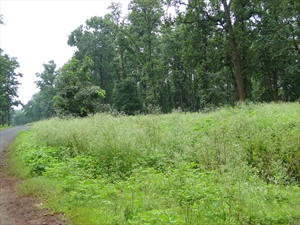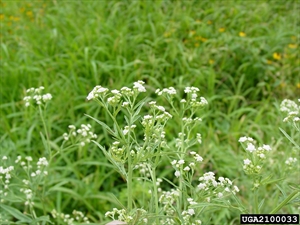Parthenium. It is also known as bittersweet, broomweed, false ragweed, wild wormwood, parthenium weed.
Pacific Pests, Pathogens and Weeds - Online edition
Pacific Pests, Pathogens & Weeds
Parthenium (503)
Parthenium hysterophorus. It is a member of the Asteraceae.
Asia, Africa, North, South and Central America, the Caribbean, Europe (restricted), Oceania. It is present in Australia, French Polynesia, New Caledonia, Papua New Guinea, and Vanuatu. It is thought to be native to within an area extending from southern North America to South America, including parts of the Caribbean, but exactly where the boundaries occur is still under discussion.
An annual weed growing aggressively in disturbed habitats of semi-arid environments. It is found in dense stands along roadsides, riverbanks, railway lines, streams, on wasteland, agricultural land and pastures (Photo 1-3). The weed has a number of characteristics that contribute to successful invasiveness: tolerance of a wide range of soil types; adaptability to different environments including drought; allelopathic (has chemicals that inhibit growth of other plants); early flowering (can be as little as 4 weeks after germination); produces many seeds (15,000-25,000 per plant); seeds have long viability, and easily dispersed by wind, animals, machinery and vehicles. From sea level to 2500 masl.
Stems up to 2 m, covered in small stiff hairs, becoming woody and branching at the top with age, and with a long tap root. Leaves, alternately arranged along the stem, up to 30 cm long and up to 12 cm wide, on stalks, up to 2 cm long, deeply divided, undersides covered in short stiff hairs (less above), and forming a rosette at the base of the plant when young (Photo 4). Later leaves smaller and less divided. Flower heads in clusters at the end of branches arising from the axils of leaves, each one on a stalk 1-8 mm long, white or cream with five very small 'petal'-like ray florets (female), 0.3-1 mm long, with many (12-60) small disc florets (male) at the centre (Photo 5). The flower heads have green 'leaf'-like structures (bracts) behind them. The five fruits contain seeds each with two appendages that help with wind dispersal. Seeds remain viable for 4-6 years, possibly, up to 8 years.
By seed on wind and water, attached to animals, clothing, machinery and vehicles, the movement of stock fodder as well as soil, sand and gravel.
Parthenium causes direct threats to: i) crop production (banana, beans, cereals, citrus, coffee, cotton, maize, orchard fruits, rice, sugarcane, and many more), ii) pasture palatability and thus carrying capacity; and iii) biodiversity of natural ecosystems - native grasslands, woodlands, riverbanks and floodplains.
Chemicals from parthenium are allelopathic, inhibiting growth of crops and native vegetation and, perhaps, reducing seed set, e.g., in maize in India. They are also allogenic with pollen causing dermatitis and hay fever in human beings. A number of serious ailments also occur in livestock from prolonged feeding on parthenium, and milk and meat are tainted affecting their value.
Indirect threats come from parthenium being a host of crop pests. CABI records the following: sunflowers (the beetle, Pseudoheteronyx - Australia); plant parasitic nematodes - USA); a moth of multiple hosts (Diacrisia obliqua - India), and the pathogens, Xanthosomas campestris pv. phaseoli; Ralstonia solanacearum; Tomato yellow leaf curl virus, Potato virus X and Potato virus Y, and the parasitic weeds, Orobanche and Cuscuta.
Traditional medicinal uses are reported, e.g., control other weeds using parthenium compost in rice paddies (presumably from its allelopathic properties), as well as a cure for numerous external and internal conditions; however, these uses do not compensate for the weed's negative economic, environmental and social impacts, and it should not be cultivated.
BIOSECURITY
The chances of introduction of parthenium is high. Countries not yet infested should consider all likely pathways for entry, and apply quarantine measures accordingly. Particular attention should be given to its high production of seed that is easily spread naturally, by animals and also by human influences.
It is a restricted invasive plant under biosecurity acts in some parts of Australia; this means - a person must not release these invasive plants into the environment, give away or sell as a plant or something infested with its seeds. Parthenium hysterophorus was declared a noxious weed in Kenya and South Africa. It is designated a quarantine pest in Europe restricting its sale and movement, and requiring government agencies to undertake eradication programs.
Parthenium hysterophorus is on the Global Invasive Species Database (2021) of information on alien and invasive species that negatively impact biodiversity, managed by the Invasive Species Specialist Group of the IUCN Species Survival Commission: (ttp://www.iucngisd.org/gisd/speciesname/Parthenium+hysterophorus).
BIOLOGICAL CONTROL
Natural enemies have been released in Australia, Nepal, Pakistan and South Africa. Most success has been achieved with: the leaf-feeding beetle, Zygogramma bicolorata; stem-galling moth, Epiblema strenuana; stem-boring beetle, Listronotus setosipennis; seed-feeding weevil, Smicronyx lutulentus; stem-galling weevil, Conotrachelus albocinereus; leaf-mining moth, Bucculatrix parthenica; and stem-boring moth, Carmentia ithacae. Additionally, a number of rust species have been tested: Puccinia abrupta var. partheniicola, has been released in Australia and East Africa, and Puccinia xanthii var. parthenii-hysterophorae (previously, Puccinia melampodii), in Australia.
CULTURAL CONTROL
- Physical & Mechanical:
- Hand-pulling is possible for small areas, but must be done before flowering and seed set, ensuring removal of all root pieces to prevent regrowth. NOTE, this is not recommended by some countries because of health concerns. When hand-pulling, wear gloves.
- Slashing, mowing and ploughing is possible, but also has the limitations noted above, plus treatments may disperse seed in the process.
- After treatment, grow crops or pasture to compete against regrowth or germination of seedlings.
- Fire:
- Fire is possible to provide short-term control. The disadvantage (in Australia) is that it opens up gaps where parthenium seedlings germinate, unless planted immediately to crops or pasture.
-
Movement of sand, soil and gravel:
-
Do not move sand, soil or gravel that might contain parthenium seeds from infested to 'clean' areas.
-
- Hygiene:
- Treat vehicles and farm machinery. If moving from areas where the weed occurs to those weed-free, wash to remove soil. This is equally important if the machinery is being imported into a country or moved within a country. Also, ensure seeds are not carried on clothes between infested and 'clean' areas.
- Livestock feed:
- Purchase only weed-free hay, and use in areas that can be easily monitored for weeds.
-
Competitive pastures:
- Maintain a vigorous competitive pasture. Choose a mix of pasture varieties (grasses and legumes) favourable for the area, and do not overgraze pastures. If practical and appropriate apply fertilizer and/or irrigation as required. Purchase seeds only from reliable (parthenium-free) sources.
-
A number of plants that are antagonistic competitors are being tested against parthenium, such as Cassia and Tagetes. Consult agricultural authorities for recommendations. This method combines suppression of parthenium with production of useful livestock fodder.
CHEMICAL CONTROL
In Australia, the following herbicides are registered: 2,4-D (amine); aminopyralid; picloram; metsulfuron-methyl; triclopyr + metsulfuron; hexazinone; dicamba. They are usually applied as foliar treatments to actively growing plants.
--------------------
Note, hexazinone is not approved for use in the EU.
____________________
When using a pesticide, always wear protective clothing and follow the instructions on the product label, such as dosage, timing of application, and pre-harvest interval. Recommendations will vary with the crop and system of cultivation. Expert advice on the most appropriate herbicides to use should always be sought from local agricultural authorities.
AUTHOR Grahame Jackson
Information from PIER (2017) Parthenium hysterophorus L., Asteraceae. Pacific Island Ecosystems at Risk (PIER), Institute of Pacific Islands Forestry. (http://www.hear.org/pier/species/parthenium_hysterophorus.htm); and CABI (2019) Parthenium hysterophorus (parthenium weed). Invasive Species Compendium. (https://www.cabi.org/isc/datasheet/45573); and DAF (2020) Parthenium Parthenium hysterophorus. Queensland Government. (https://www.daf.qld.gov.au/__data/assets/pdf_file/0004/68602/parthenium.pdf). Photo 1&2 Forrest & Kim Starr, Starr Environmental, Bugwood.org. Photo 3 Pankaj Oudhia Parthenium_infestation_in_Achanakmar_Wildlife_Sanctuary.jpg (https://en.wikipedia.org/wiki/Parthenium_hysterophorus). Photo 4 Ethel Aardvark Parthenium hysterophorus plant with flowers, Central Queensland. Photo 5 Charles T. Bryson, USDA Agriculture Research Service, Bugwood.org.
Produced with support from the Australian Centre for International Agricultural Research under project HORT/2016/185: Responding to emerging pest and disease threats to horticulture in the Pacific islands, implemented by the University of Queensland and the Secretariat of the Pacific Community.








